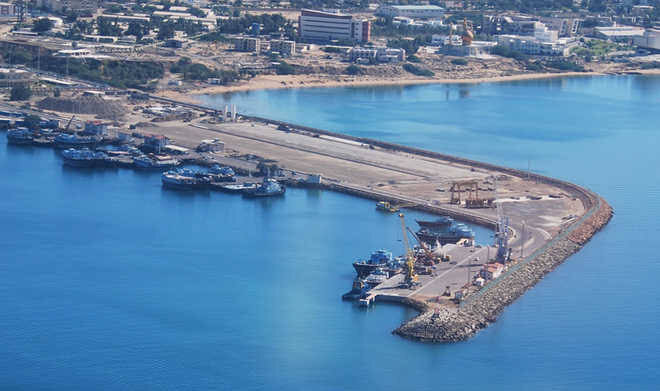Why are terrorists targeting Makran?
Development of Makran coasts expected to transform economy of Sistan and Balouchestan

TEHRAN - On April 3, security forces engaged in a 17-hour battle against terrorists in two separate cities within Iran's southeastern province of Sistan and Balouchestan.
During the confrontation, 12 members of the Islamic Revolution Guard Corps (IRGC) and 4 police officers lost their lives as they fought to clear the region of terrorists affiliated with the so-called Jaish-ul-Adl outfit.
The clash ensued after 18 members of the terrorist group launched simultaneous attacks on five military bases overnight. In Chabahar, they escalated the situation by seizing a residential building and taking civilians hostage while resisting security forces. Ultimately, all 18 terrorists were neutralized.
The terrorist group cited its motive for the attacks as obstructing the "Makran Coasts Development Plan." It claimed that the plan which is expected to rake in millions of dollars for locals in southeastern Iran aims to “change the Sunni demographic” of the region.
Makran, a historically significant region stretching from the mountains west of Jask to portions of Pakistan's Balouchestan province along the Sea of Oman, has witnessed recent infrastructural development by Iran. The Chabahar port has particularly emerged as a crucial trade gateway connecting the Indian Ocean with landlocked nations in Central Asia.
External separatist groups and oppositionists have persistently attempted to discredit the Iranian government's economic initiatives in Sistan and Balouchestan province, portraying them as detrimental to local interests. Often featured on Western-based news channels, Balouch separatists have propagated sensational claims, including the unfounded assertion that over 20 million Shia Muslims would be relocated to the port city of Chabahar. It's worth noting that Tehran's population, with the capital city having been the economic and cultural hub of Iran, has only increased by 7 million over the past 45 years.
Despite being a Shia-majority nation, Iran ensures equal rights and freedoms for all religious sects and minorities. Every religious group has representation in the parliament, and individuals from diverse backgrounds can ascend to prominent political, diplomatic, and military positions. For instance, the Iranian Army's Navy, one of Iran’s most important military forces, is led by Rear Admiral Shahram Irani, a Sunni commander.
Iran's judiciary and law enforcement authorities also make sure to uphold the rights of religious minorities. As warned by the Leader of the Islamic Revolution, the desecration of the sanctities of any religious group is deemed a grave offense with strict legal consequences.
Despite centuries and perhaps thousands of peaceful coexistence among Iranian citizens, media outlets affiliated with Israel, Western powers, and Wahabi groups persist in sowing discord under various pretexts.
For the past several years, their main tool for destabilizing southeastern Iran and creating friction has been the Jaish-ul-Adl, known within Iran as Jaish-ul-Zolm. Pictures of the individuals liquidated on April 3 show the group had managed to equip its terrorists with advanced weapons, making them resemble members of a conventional army rather than a terrorist entity residing in the deserted mountains of Pakistan.
"Iran occupies a pivotal position globally, offering significant potential to serve as a key economic corridor in the future. This realization has spurred the nation to intensify its development efforts along coastal regions," remarked Vahid Raz Afzoon, an expert in coastal development, speaking to the Tehran Times. "Makran, particularly Chabahar, receives special attention from Iranian authorities. The area holds immense promise to evolve into an economic nucleus, providing substantial benefits primarily to the locals of Sistan and Balouchestan, many of whom currently seek employment opportunities in other provinces."
Sistan and Balouchestan province has lagged behind other Iranian regions in terms of economic development. Pundits believe that the development of the Makran coasts could herald a transformative era for the area.
"A multitude of projects exist that could contribute to the prosperity of this region. As progress unfolds, elites from the province, currently residing in urban centers such as Tehran, Esfahan, and Mashhad, will get the chance to work in their hometown," Raz Afzoon elaborated. "Iran, like many other developing nations, has concentrated its development efforts in the capital and surrounding regions. It is imperative that this paradigm shifts. People in all 31 provinces should be able to pursue career opportunities in their hometowns and remain close to their families once they finish their studies,” he added.
Decentralization is an issue several Asian countries are grappling with including established economies like Japan and South Korea. The Iranian government is also trying to come up with more plans and policies to dial back overdependence on Tehran and its environs. In Iran, however, it seems that authorities have more to overcome than statistical and infrastructural hurdles.
“Separatists residing abroad and terrorists like Jaish-ul-Adl know the development of Makran will benefit everyone including the locals. That’s why you don’t see them coming up with a meaningful argument,” Raz Afzoon stated.
The routine assaults by terrorists will most likely demotivate foreign investors like India and China, preventing them from spending money on Iran’s mega projects. The longer these attacks continue, the more locals in southeastern Iran are forced to wait to finally enjoy the same amount of prosperity as those residing in the capital.
In fact, the attacks that shook the region earlier in the month are already taking a toll on the region's economy. Tourism has been booming in Sistan and Balouchestan in the last few years. Chabahar in particular, was one of the most popular tourist destinations for Iranians in 2022 and 2023. With people fearing that they could get tangled in a spontaneous armed clash, travel agencies predict that the city will lose a significant number of visitors in the upcoming cooler seasons.
